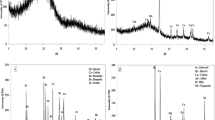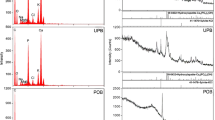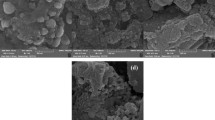Abstract
Biochar was for the first time produced from Suaeda glauca. The immobilization of Pb and Cd by this biochar and pig manure biochar was examined in two types of soils by diethylene triamine pentaacetic acid (DTPA) extraction. Addition of biochars decreased DTPA extractable Pb and Cd in Fluvo-aquic soil with reduction rates being 11.3%–48.4% and 0.74%–64.9% compared with the control treatment. The pig manure biochar favored the immobilization of Pb and S. glauca biochar favored the immobilization of Cd. Biochars can effectively immobilize heavy metals in Fluvo-aquic soil. However, the addition of biochars increased extractable Pb and Cd in red soil, with pig manure biochars showing greater rates. This is ascribed to that the competition effects of ions released from biochar enhanced the moving of heavy metals from iron and manganese oxides bound form to organic matter bound form, and hence enhanced the mobility and bioavailability of heavy metals.



Similar content being viewed by others
References
Ahmad M, Lee SS, Lee SE et al (2016a) Biochar-induced changes in soil properties affected immobilization/mobilization of metals/metalloids in contaminated soils. J Soils Sedim 17:717–730
Ahmad M, Ok YS, Kim BY et al (2016b) Impact of soybean stover- and pine needle-derived biochars on Pb and As mobility, microbial community, and carbon stability in a contaminated agricultural soil. J Environ Manage 166:131–139
Ahumada I, Mendoza J, Navarrete E et al (2008) Sequential extraction of heavy metals in soils irrigated with wastewater. Commun Soil Sci Plant Anal 30:1507–1519
Beesley L, Marmiroli M (2011) The immobilisation and retention of soluble arsenic, cadmium and zinc by biochar. Environ Pollut 159:474–480
Bian R, Joseph S, Cui L et al (2014) A three-year experiment confirms continuous immobilization of cadmium and lead in contaminated paddy field with biochar amendment. J Hazard Mater 272:121–128
Bolan N, Kunhikrishnan A, Thangarajan R et al (2014) Remediation of heavy metal(loid)s contaminated soils-To mobilize or to immobilize? J Hazard Mater 266:141–166
Cao X, Ma L, Liang Y et al (2011) Simultaneous immobilization of lead and atrazine in contaminated soils using dairy-manure biochar. Environ Sci Technol 45:4884–4889
Chen D, Li R, Bian R et al (2017) Contribution of soluble minerals in biochar to Pb2+ adsorption in aqueous solutions. BioResources 12:1662–1679
Chun Y, Sheng G, Chiou CT et al (2004) Compositions and sorptive properties of crop residue-derived chars. Environ Sci Technol 38:4649–4655
Ding F, He Z, Liu S et al (2017) Heavy metals in composts of China: Historical changes, regional variation, and potential impact on soil quality. Environ Sci Pollut Res 24:3194–3209
Dong Y, Wang H, Chang E et al (2019) Alleviation of aluminum phytotoxicity by canola straw biochars varied with their cultivating soils through an investigation of wheat seedling root elongation. Chemosphere 218:907–914
Fang G, Zhu C, Dionysiou DD et al (2015) Mechanism of hydroxyl radical generation from biochar suspensions: Implications to diethyl phthalate degradation. Biores Technol 176:210–217
GB/T 23739 (2009) Soil quality-Analysis of available lead and cadmium contents in soils- Atomic adsorption spectrometry (in Chinese)
Ghaffar A, Ghosh S, Li F et al (2015) Effect of biochar aging on surface characteristics and adsorption behavior of dialkyl phthalates. Environ Pollut 206:502–509
Hass A, Gonzalez JM, Lima IM et al (2012) Chicken manure biochar as liming and nutrient source for acid Appalachian soil. J Environ Qual 41:1096–1106
He Q, Singh BR (1993) Effect of organic matter on the distribution, extractability and uptake of cadmium in soils. J Soil Sci 44:641–650
Houben D, Evrard L, Sonnet P (2013) Mobility, bioavailability and pH-dependent leaching of cadmium, zinc and lead in a contaminated soil amended with biochar. Chemosphere 92:1450–1457
Igalavithana AD, Lee SE, Lee YH et al (2017) Heavy metal immobilization and microbial community abundance by vegetable waste and pine cone biochar of agricultural soils. Chemosphere 174:593–603
Jiang J, Xu R (2013) Application of crop straw derived biochars to Cu(II) contaminated Ultisol: evaluating role of alkali and organic functional groups in Cu(II) immobilization. Bioresour Technol 133:537–545
Keiluweit M, Kleber M (2009) Molecular-level interactions in soils and sediments: the role of aromatic pi-systems. Environ Sci Technol 43:3421–3419
Kelly CN, Peltz CD, Stanton M et al (2014) Biochar application to hardrock mine tailings: Soil quality, microbial activity, and toxic element sorption. Appl Geochem 43:35–48
Kumarathilaka P, Ahmad M, Herath I et al (2018) Influence of bioenergy waste biochar on proton- and ligand-promoted release of Pb and Cu in a shooting range soil. Sci Total Environ 625:547–554
Lee Y, Park J, Ryu C et al (2013) Comparison of biochar properties from biomass residues produced by slow pyrolysis at 500 ℃. Bioresour Technol 148:196–201
Lian F, Sun B, Chen X et al (2015) Effect of humic acid (HA) on sulfonamide sorption by biochars. Environ Pollut 204:306–312
Li B, Chen H, Lan Z et al (2017) Distribution, isomerization and enantiomer selectivity ofhexabromocyclododecane (HBCD) diastereoisomers in different tissue andsubcellular fractions of earthworms. Ecotoxicol Environ Saf 139:326–334
Liu N, Charrua AB, Weng CH et al (2015) Characterization of biochars derived from agriculture wastes and their adsorptive removal of atrazine from aqueous solution: a comparative study. Bioresour Technol 198:55–62
Lu L, Sahajwalla V, Harris D (2000) Characteristics of chars prepared from various pulverized coals at different temperatures using drop-tube furnace. Energy Fuels 14:869–876
Lu K, Yang X, Gielen G et al (2017) Effect of bamboo and rice straw biochars on the mobility and redistribution of heavy metals (Cd, Cu, Pb and Zn) in contaminated soil. J Environ Manage 186:285–292
MEP and MLR (Ministry of Environmental Protection and Ministry of Land and Resource of the People’s Republic of China), (2014). The Bulletin of Nationwide Soil Pollution Status Survey (April, 2014. Index No. 000014672/2014-00351) (in Chinese)
Mohan D, Pittman CU Jr, Brick, AM et al (2007) Sorption of arsenic, cadmium, and lead by chars produced from fast pyrolysis of wood and bark during bio-oil production. J Colloid Interface Sci 310:57–73
Ok YS, Usman AR, Lee SS et al (2011) Effects of rapeseed residue on lead and cadmium availability and uptake by rice plants in heavy metal contaminated paddy soil. Chemosphere 85:677–682
Park JH, Choppala GK, Bolan NS et al (2011) Biochar reduces the bioavailability and phytotoxicity of heavy metals. Plant Soil 348:439–451
Poo KM, Son EB, Chan JS et al (2018) Biochars derived from wasted marine macro-algae (Saccharina japonica and Sargassum fusiforme) and their potential for heavy metal removal in aqueous solution. J Environ Manage 206:364–372
Rajapaksha AU, Chen SS, Tsang DC et al (2016) Engineered/designer biochar for contaminant removal/immobilization from soil and water: Potential and implication of biochar modification. Chemosphere 148:276–291
Ren X, Sun H, Wang F et al (2018) Effect of aging in field soil on biochar's properties and its sorption capacity. Environ Pollut 242:1880–1886
Rinklebe J, Shaheen SM, Frohne T et al (2016) Amendment of biochar reduces the release of toxic elements under dynamic redox conditions in a contaminated floodplain soil. Chemosphere 142:41–47
Shen Z, Zhang Y, Jin F et al (2017) Qualitative and quantitative characterisation of adsorption mechanisms of lead on four biochars. Sci Total Environ 609:1401–1410
Sun X, Gao Y, Wang D et al (2017) Stoichiometric variation of halophytes in response to changes in soil salinity. Plant Biol 19:360–367
Uchimiya M, Bannon DI, Wartelle LH et al (2012) Lead retention by broiler litter biochars in small arms range soil: Impact of pyrolysis temperature. J Agric Food Chem 60:5035–5044
Uchimiya M, Chang S, Klasson KT et al (2011) Screening biochars for heavy metal retention in soil: Role of oxygen functional groups. J Hazard Mater 190:432–441
Van Zwieten L, Kimber S, Morris S et al (2009) Effects of biochar from slow pyrolysis of papermill waste on agronomic performance and soil fertility. Plant Soil 327:235–246
Wang F, Ren X, Sun H et al (2016) Sorption of polychlorinated biphenyls onto biochars derived from corn straw and the effect of propranolol. Bioresou Technol 219:458–465
Wang H, Dong Y, Tong X et al (2019) The amelioration effects of canola straw biochar on Ultisol acidity varied with the soil in which the feedstock crop was cultivated. J Soils Sedim 20:1424–1434
Wang T, Sun H, Ren X et al (2018) Adsorption of heavy metals from aqueous solution by UV-mutant Bacillus subtilis loaded on biochars derived from different stock materials. Ecotoxicol Environ Saf 148:285–292
Wang X, Zhang C, Qiu B et al (2017) Biotransfer of Cd along a soil-plant: mealybug-ladybird food chain: a comparison with host plants. Chemosphere 168:699–706
Wang Y, Hu Y, Zhao X et al (2013) Comparisons of biochar properties from wood material and crop residues at different temperatures and residence times. Energy Fuels 27:5890–5899
Wang Z, Liu G, Zheng H et al (2015) Investigating the mechanisms of biochar's removal of lead from solution. Bioresour Technol 177:308–317
Xiao X, Chen B, Chen Z et al (2018) Insight into multiple and multilevel structures of biochars and their potential environmental applications: a critical review. Environ Sci Technol 52:5027–5047
Yang Y, Christakos G, Guo M et al (2017) Space-time quantitative source apportionment of soil heavy metal concentration increments. Environ Pollut 223:560–566
Yang Y, Zhang W, Qiu H et al (2016) Effect of coexisting Al(III) ions on Pb(II) sorption on biochars: Role of pH buffer and competition. Chemosphere 161:438–445
Yuan J, Xu R, Zhang H et al (2011) The forms of alkalis in the biochar produced from crop residues at different temperatures. Bioresour Technol 102:3488–3497
Zhu Q, Huang D, Liu S et al (2012) Assessment of single extraction methods for evaluating the immobilization effect of amendments on cadmium in contaminated acidic paddy soil. Plant Soil Environ 58:98–103
Acknowledgements
This study is supported by Ministry of Science and Technology of China (the National Key Research and Development Project of China, 2018YFC1800702) and Ministry of Education of China (111 Program, T2017002).
Author information
Authors and Affiliations
Corresponding author
Additional information
Publisher's Note
Springer Nature remains neutral with regard to jurisdictional claims in published maps and institutional affiliations.
Electronic supplementary material
Below is the link to the electronic supplementary material.
Rights and permissions
About this article
Cite this article
Liu, Y., Wang, F., Yin, Z. et al. Immobilization of Lead and Cadmium in Soil Using Biochars Derived from Pig Manure and Suaeda glauca. Bull Environ Contam Toxicol 105, 146–154 (2020). https://doi.org/10.1007/s00128-020-02886-x
Received:
Accepted:
Published:
Issue Date:
DOI: https://doi.org/10.1007/s00128-020-02886-x




